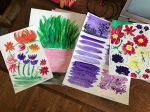I was thinking recently of Salt, Fat, Acid, Heat by Samin Nosrat. I was thinking of the cookbook, specifically, because it’s cooking season again in my world, and this is the time of year I pull out my favourite cookbooks and turn to the recipes that comfort; the recipes that nurture as well as nourish.
I do cook in the spring and summer months, but that kind of cooking is different. I can’t explain it fully, but spring and summer cooking, to me, is “Just-in-time” cooking. It’s vegetables from the farmer’s market made purchased that morning and turned into big colourful salads or grilled to perfection on a BBQ, occasionally with hamburgers, hotdogs, sausages or fish. It’s rarely, for our family, a season of leftovers. Autumn and winter cooking, by contrast, is “Just-in-case” cooking.
Both these terms are business terms which is very odd coming from me, an extremely non-business person, but they seem to work well to explain what I mean here. The Just-in-time strategy refers to inventory or stock that is kept low and replenished on an as-needed basis. This, to me, is summertime food. The Just-in-case strategy refers to maintaining a large supply of inventory so as not to run out. This then, in my scenario, is fall- and wintertime food.
This is the season to cook big batches of your favourite things and store them in the freezer. It’s the season for building multiple lasagnas and using all the elements on the stove to make double- and triple-recipe curries. It’s frozen meat and veggies that can be thawed slowly in the fridge during the week for a binge of stew-making on the weekends. And it’s my favourite time of year.
Samin Nosrat, in her excellent book mentioned above, has some of these kinds of recipes, and when I pulled out the book, I reminisced about watching her wonderful TV show of the same name, and reminded myself that I need to watch it again. If you haven’t seen it, it’s a marvel. Nosrat travels the world to highlight the specific elements (the salt, fat, acid and heat) needed for cooking and creating wonderful food. It’s highly educational and is also a beautiful testament to the power food has to bring people together in community. There are people who will tell you that food isn’t love, but they are wrong. Food is definitely love. Cooking and/or sharing a meal with your people is to me one of the highest forms of love. My dad, who died nineteen years ago this month, instilled this into me, but what solidified it completely is that the last time I saw my dad before he went into hospital, he was doing just that.
John and the kids and I were at the family cottage the weekend of the massive August 2003 blackout. Our power, oddly, was restored before Hamilton’s and so I called my parents and suggested they come to the lake with us. They showed up with a whole bunch of pickerel that my dad bought the day of the blackout that needed to be cooked before it spoiled, so he invited the neighbours to a big fish fry. He was in his element. Battering fish and dropping it into the oil, chatting and laughing with the boys and the neighbours and just having the best time. I am so glad he had that. I’m so grateful we all had that.
October is a beautiful month. It’s also the gateway to the dark months and I know there are those who miss and crave and yearn for the light and the warmth of summer and I get it! I do love a good summer backyard BBQ with friends and family, but my absolute favourite shared meals are inside. I can’t resist a bright kitchen with the oven on and all four elements bubbling away, creating steam and fogging up the windows. I adore seeing a group of friends gathered around a big table in a warmly-lit dining room. Flushed faces sipping wine, laughing and chatting, and helping themselves to seconds while the cold wind blows the leaves around outside.
Every episode of Salt, Fat, Acid, Heat is beautiful and the ending made me cry because Nosrat’s whole thing is about sharing food with the people you love, learning from each other, and making memories around the table. And every time I do that, every time I host my friends or make a meal for John and Charles and Max I think of my dad and how he created something so special without even realizing it. He thought he was just making dinner for the people he loved the most. But he was doing so much more.







